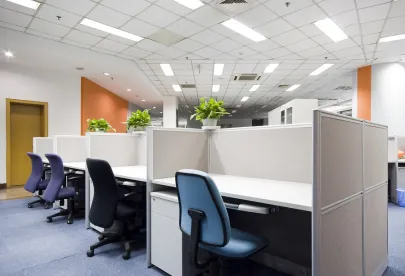On Wednesday, May 27, 2020, the Centers for Disease Control and Prevention (“CDC”) issued new guidance (available here) detailing how employers can safely reopen offices following months of closure amid the ongoing COVID-19 pandemic. The CDC guidance provides a step-by-step checklist for employers to follow to ensure that their office spaces are physically prepared for workers to return to work as they proceed with life beyond the pandemic.
When employees do return, offices are going to look a lot different from when they left. The CDC recommendations range from technical advice on ventilation systems to the abolition of the traditional handshake to employee temperature testing protocols. Key provisions are summarized below.
Create a COVID-19 Workplace Health and Safety Plan
-
The CDC’s Interim Guidance for Businesses and Employers provides guidelines and recommendations that all employers can use to protect their employees, clients, visitors, and vendors. Office building managers and employers within office buildings should use this guidance to establish, and update as necessary, their own workplace health and safety plan tailored to its space and workforce.
-
The plan should identify all areas and job tasks with potential exposure to COVID-19 and include measures to eliminate or reduce such risks.
Before Resuming Operations, Assess Whether the Building Is Ready For Occupancy and, If Not, Prepare It For Occupancy
-
Ensure that ventilation systems in the facility operate properly.
-
Increase circulation of outdoor air as much as possible by opening windows and doors, using fans, and other methods.
-
Check for hazards associated with prolonged facility shutdown such as mold growth, rodents or pests, or issues with stagnant water systems, and take appropriate remedial actions.
Identify Where and How Workers Might Be Exposed to COVID-19 at Work
-
Conduct a thorough assessment of the workplace to identify potential workplace hazards that could increase risks for COVID-19 transmission.
-
Identify work and common areas where employees could have close contact (within 6 feet) with others — for example, meeting rooms, break rooms, the cafeteria, locker rooms, check-in areas, waiting areas, and routes of entry and exit.
-
In workplace communication plans, include all employees, such as management, staff, utility employees, relief employees, janitorial staff, maintenance staff, and supervisory staff.
-
If contractors are employed in the workplace, develop plans to communicate with the contracting company regarding modifications to work processes and requirements for the contractors to prevent transmission of COVID-19.
Identify and Isolate Workplace Hazards
-
Modify or adjust seats, furniture, and workstations to maintain social distancing of 6 feet between employees.
-
Physically separate employees in all areas of the facilities including work areas and other areas such as meeting rooms, break rooms, parking lots, entrance and exit areas, and locker rooms. When physical barriers are not possible, use signs, tape marks, or other visual cues such as decals or colored tape on the floor, placed 6 feet apart, to separate employees.
-
Replace high-touch communal items, such as coffee pots, water coolers, and bulk snacks, with alternatives such as pre-packaged, single-serving items.
-
Improve ventilation in the building by increasing the percentage of outdoor air or improving central air filtration.
-
Consider using ultraviolet germicidal irradiation (UVGI) as a supplement to help inactivate the virus.
Administrative Controls: Change the Way People Work
-
Actively encourage employees who have symptoms of COVID-19 or who have a sick family member at home with COVID-19 to notify their supervisor and telework or stay home.
-
Consider conducting daily in-person or virtual health checks (e.g., symptoms and/or temperature screening) of employees before they enter the work site.
-
Stagger shifts, start times, and break times as feasible to reduce the density of employees in common areas such as screening areas, break rooms, and locker rooms.
-
Clean and disinfect high touch surfaces, including door knobs, work stations, keyboards, telephones, handrails, and copiers/printers.
-
Establish policies and practices for social distancing, such as prohibiting handshakes, hugs, and fist bumps and encouraging the use of outdoor seating areas for lunches, breaks, and meetings.
-
For employees who commute to work using public transportation or ride sharing, consider offering the following support:
-
Offer employees incentives to use forms of transportation that minimize close contact with others, such as offering reimbursement for parking for commuting to work alone or single-occupancy rides.
-
Allow employees to shift their hours so they can commute during non-peak busy hours.
-
-
Employees should wear a cloth face covering to cover their nose and mouth in all areas of the business. Note, however, that the CDC clarifies that cloth face coverings are not considered personal protective equipment as they prevent the employee from spreading infection but do not protect the employee from infection.
Educate and Train Employees and Supervisors How To Protect Themselves in the Workplace
-
Communication and training about workplace safety should be easy to understand, be in preferred languages spoken or read by the employees, and include accurate and timely information.
-
Download and print the CDC’s COVID-19 recommendation posters (available here), some of which are translated into different languages.
Employer Takeaways
Some of the above measures are consistent in keeping with what some employers are already planning, while other employers may decide that it is easier to maintain telework options for employees to work from home. In addition to the guidance issued from the CDC, employers should continue to monitor other applicable guidelines to ensure compliance as they return back to physical workplaces. For example:
-
As detailed in a previous blog post (available here), California employers must continue to follow guidelines issued by the California’s Division of Occupational Safety and Health (“Cal/OSHA”).
-
Additionally, as explained in a previous blog post (available here), employers who intend to test employees for COVID-19 should ensure they are following appropriate Equal Employment Opportunity Commission (“EEOC”) guidance.
-
Employers should also ensure they are following applicable guidelines with regard to temperature testing employees in the workplace, as detailed in our previous blog post (available here).
Employers with questions about returning to work should consult with experienced employment counsel.
As you are aware, things are changing quickly and there is a lack of clear-cut authority or bright line rules on implementation. This article is not intended to be an unequivocal, one-size fits all guidance, but instead represents our interpretation of where things currently and generally stand. This article does not address the potential impacts of the numerous other federal, state and local orders that have been issued in response to the COVID-19 pandemic, including, without limitation, potential liability should an employee become ill, requirements regarding family leave, sick pay and other issues.
*Co-authored by Jamie Moelis , Law Clerk in the New York office.



 />i
/>i

